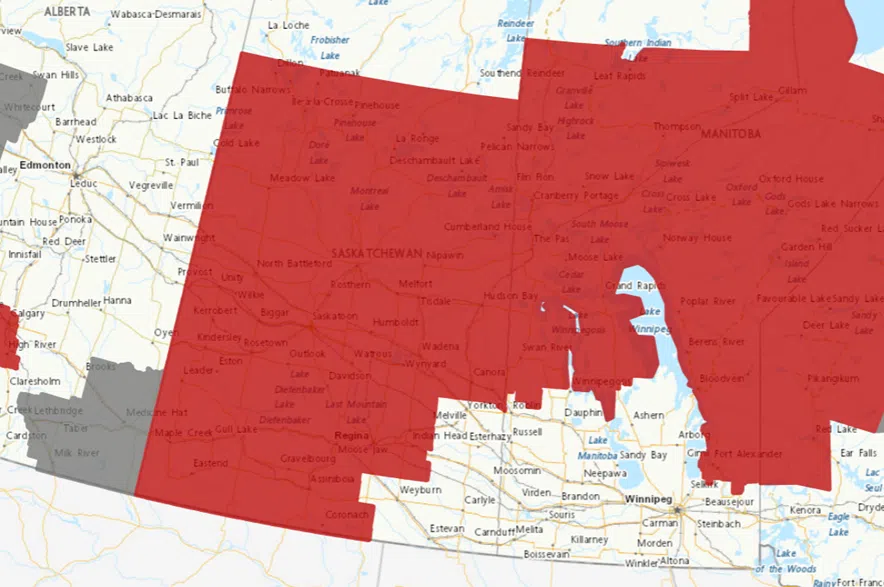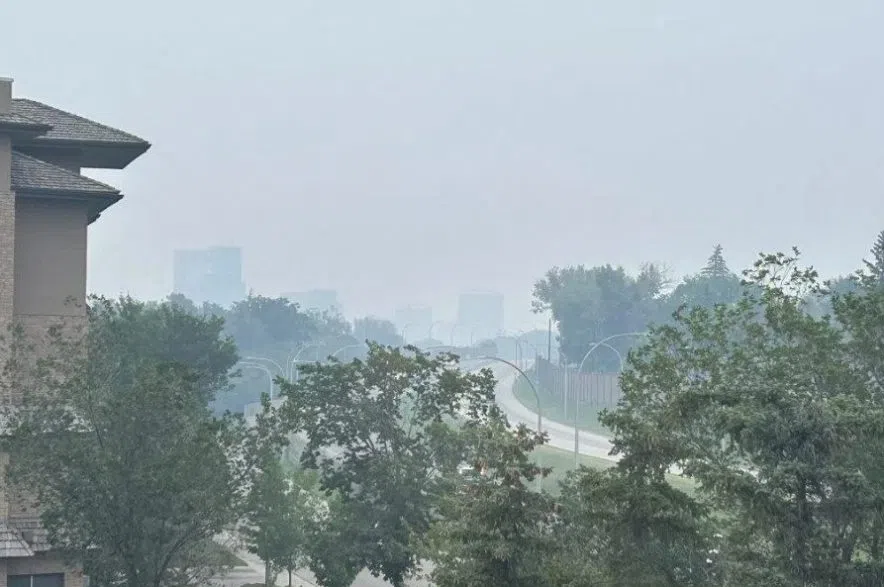Saskatchewan may not see clear blue skies for the next few days.
Almost all of central and southern Saskatchewan was included under special air quality warnings from Environment Canada on Tuesday due to wildfire smoke drifting down from the north.
Read more:
- Flash flooding hits Saskatoon’s east side during Sunday storm
- Heavy weekend rain didn’t do much for Sask. wildfires, SPSA reports
- Tornado appears to touch down northwest of Allan Sunday evening
Senior meteorologist Robyn Dyck said there is very little wind to help clear the smoke out.
“There’s not much on the horizon changing,” she said on Tuesday. “For the foreseeable future it might be pretty bad.”
Dyck said the smoke may start to clear on Wednesday evening, but she expects the improvement to be slow.
“We’ll get a reprieve, and then it may just come back in, depending on on the wind direction,” she explained. “Until the fires are completely out, there won’t be an end to the smoke.”
Both Regina and Saskatoon were rated as a 10+ on the weather service’s air quality health index on Tuesday morning, the highest level on the scale.

Air quality warnings from Environment Canada covered the majority of Saskatchewan on Tuesday morning. (Environment Canada)
“During heavy smoke conditions, everyone’s health is at risk regardless of their age or health status,” Environment Canada said in a statement.
“Limit time outdoors. Reschedule or cancel outdoor sports, activities and events.”
Earlier this month, a Saskatchewan Roughriders home game at Mosaic Stadium in Regina had to be postponed due to smoke drifting into the city. On Friday, the team is expected to welcome the Edmonton Elks to the stadium for a game.
As for Friday’s forecast, Dyck said smoke is tricky to predict.
“Friday is quite far out to be able to give an accurate forecast for smoke at this point,” she said.
Environment Canada suggests people check the Air Quality Health Index daily to determine how much time to spend outside. Here’s how to interpret the index:
How do I find out my local air quality reading?
Environment Canada’s air quality index can be found here.
You can take a look at the ratings in communities across your province or territory.
A rating of 1-3 is low risk, 4-6 is moderate risk, 7-10 is high risk and over 10 is very high risk.
The risk designations can change regularly in the same community, Environment Canada says, so it’s important to keep checking the air quality forecast.
What do the risk ratings mean?
Environment Canada, in consultation with Health Canada, has different recommendations for people especially at risk of suffering health problems when exposed to poor air quality compared to the general population.
“At risk” people include those with respiratory issues such as asthma, chronic obstructive pulmonary disease (COPD), pneumonia, as well those with as heart disease. Infants, young children, pregnant people and elderly people are also considered at higher risk.
The government agency lists the various health conditions that put you at higher risk on this website.
Here’s how to interpret the Air Quality Health Index guidance:
“Low risk” means everyone can safely be outdoors.
“Moderate risk” means the general population doesn’t need to change their usual outdoor activities unless they have symptoms such as coughing and throat irritation. But people at risk should “consider reducing or rescheduling strenuous activities outdoors.”
“High risk” means those at risk should reduce or reschedule strenuous activities outdoors. Children and seniors should “take it easy.” The general population should consider reducing or rescheduling strenuous activities if they start coughing or their throats become irritated.
“Very high risk” means everyone should reduce or reschedule strenuous activities. People at risk should avoid outdoor activities altogether
–with files from the Canadian Press











